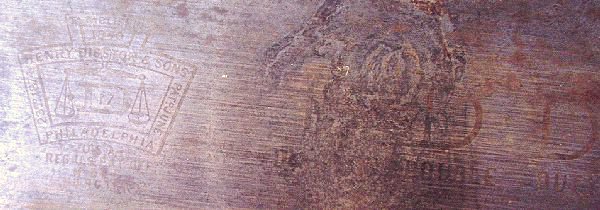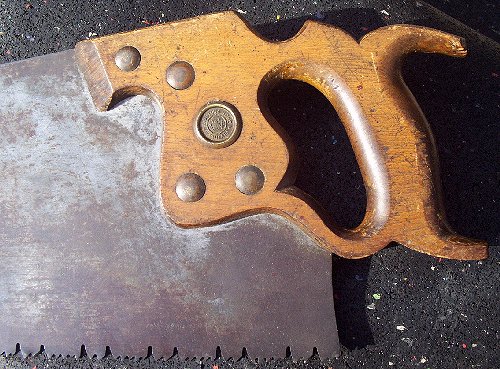
Disston D-17 Handsaw




The D-17 Double Duty saw has an alternating pattern of five crosscut teeth and two rip teeth, with the sets of teeth separated by a deep gullet to carry out saw dust. It was designed to be used by framing carpenters as both a crosscut and rip saw as well as one to be used for fast diagonal cuts. The first of the two rip teeth is filed at the same rake angle as the crosscut teeth, making it a somewhat compromised rip tooth. The saw does cut wood and was offered for about 30 years, from around WWI until after WWII. It must not have sold spectacularly because they are rarely found. The shape of the blade and handle are the same as the D-8 model. This example features a beech covertop handle, the catalog specifies only hardwood. Just to be consistant with the rest of the Disston line in the offering of endless options, there was a straightback version of the D-17, numbered the D-117.
|
 |
This post-1928 version of the D-17 features a handle that looks like a D-7. The entire line of Disston saws was changed in 1928. This handle has four saw nuts instead of the earlier five. |

Refined Crucible Steel Blade, Warranted. Hardwood Handle, full Polished, Brass Screws. The combination of teeth in this saw, alternate sections of five regular cross-cutting teeth and two ripping teeth, separated by numerous deep gullets for full clearance, insures free running, easy, very rapid and clean cutting in heavy work, whether cross-cutting or ripping, and especially for sawing diagonally across the grain, as its name implies.This saw is particularly adapted for general construction work of all kinds; studding-up houses, shoring for sewers, making forms for concrete buildings, railroad work, millwright, farm use, etc. The Disston Double Duty Saw far excels any other pattern of saw ever made for like utility, and is easily kept in order. Skewback made in 26-inch length only. $25.00 per dozen [wholesale].

The most efficient saw ever made for double duty work-that is, both cross-cut and rip sawing with the same tool. It is very popular for fast, rough sawing in general construction work of all kinds-studding up houses, shoring for sewers, making forms for concrete buildings, railroad work, farm use, etc. The D-17 can be used for cross-cutting, ripping, or sawing diagonally across the grain.The combination of teeth in the saw-alternating sections of five regular cross-cutting and two ripping teeth, separated by deep gullets for clearance, insures easy running and fast cutting in rough work. The saw is easily kept in order as the teeth are sharpened just as are ordinary cross-cut and rip teeth. It is occasionally necessary to deepen the gullets between the sections of teeth, and for this purpose we recommend the 4-inch Disston Mill File with two round edges.
The D-17 is of the same quality and finish as the D-8, but costs slightly more because of the special tooth-edge.
The D-117 is exactly the same as the D-17, except that the blade is straight-back.
The D-117 does not appear in the 1924 catalog.

The most efficient saw ever made for double duty work -- that is, both cross-cut and rip sawing with the same tool. It is very popular for fast, rough sawing in general construction work of all kinds -- studding up houses, shoring for sewers, making forms for concrete buildings, railroad work, farm use, etc. The D-17 can be used for cross-cutting, ripping, or sawing diagonally across the grain.The combination of teeth in the saw -- alternating sections of five regular cross-cutting and two ripping teeth, separated by deep gullets for clearance, insures easy running and fast cutting in rough work. The saw is easily kept in order as the teeth are sharpened just as are ordinary cross-cut and rip teeth. It is occasionally necessary to deepen the gullets between the sections of teeth, and for this purpose we recommend the 4-inch Disston Mill File with two round edges.
The D-17 is of the same quality and finish as the D-8, but costs slightly more because of the special tooth-edge.
Made in 26" length only [1926].

Double-duty saw, used for both ripping and cross-cutting.
Also cuts diagonally across grain.
Blade made narrower. Improved pattern of beechwood handle.
Brass screws. New weatherproof finish.
Higher polish, greater beauty. Disston true-taper grind.
Made in one length of blade only -- 26 inches.
Price, 26" length, $3.70 each

Regular Pattern Skewback. Known as the Disston Double Duty saw. The most efficient saw ever made for both crosscutting and ripping with the same tool. Widely used for fast, rough sawing in general construction work. The arrangement of the teeth, five regular cross-cutting teeth alternating with two ripping teeth, separated by deep gullets for clearance, insures easy and fast cutting. Disston true-taper grind. Beechwood handle; new weatherproof finish, brass screws. Made in 26-inch length only. Price, $3.70 each.

The Disston No. D-17 Regular Pattern is a double duty saw used for both ripping and crosscutting. It also cuts diagonally across the grain. An excellent saw for use in general construction work of all kinds, studding up houses, making forms for concrete building, railroad work, millwrighting, heavy pruning and other rough work.Blade of Disston steel; true-taper ground; hardened and tempered; high polish, striped back; alternate sections of five regular crosscutting and two ripping teeth. The combination of teeth with numerous deep gullets insures free running and very rapid cutting. The teeth are of regular form and can be sharpened with regular slim taper files.
Handle, beechwood, weatherproof finish; large, comfortable grip; four brass screws.
|
Length of Blade |
Weight per doz. |
Retail Price per doz. |
| 26 inches | 25 1/2 lbs. | $44.40 |
Packed 1/6 dozen in box.
Width of blade: Butt 7 inches; Point 2 1/8 inches.

Regular Pattern Skewback. This is a double duty type saw. Can be used for either ripping, cross-cutting or cutting diagonally. Alternate sections of five cross-cutting and two ripping teeth with fine teeth at point for starting cut. Cover-top, beechwood handle, weatherproof finish. Disston Steel blade, polished, striped back, true taper ground.
The D-17 does not appear in the 1953 catalog.
